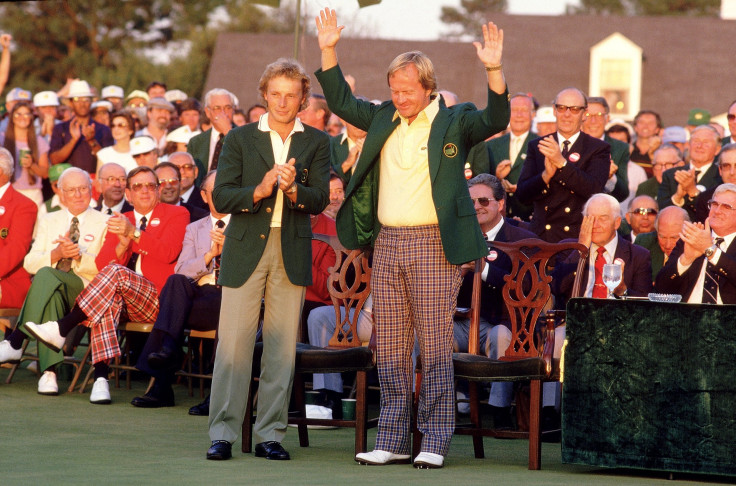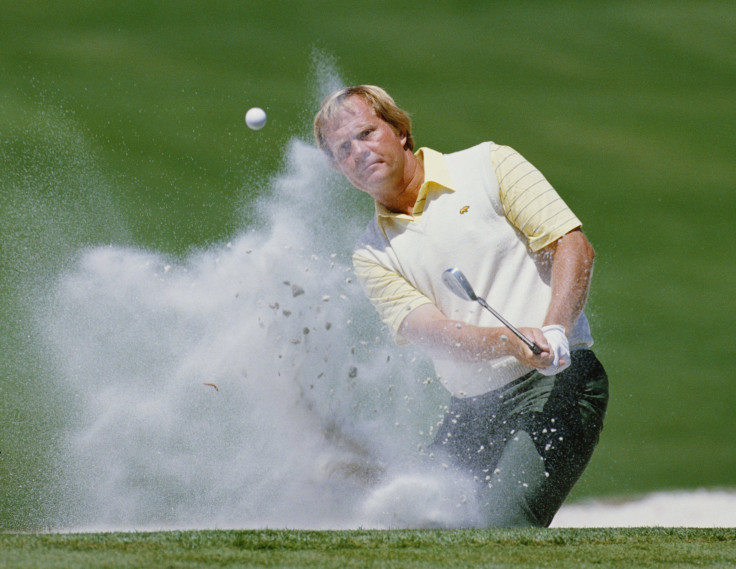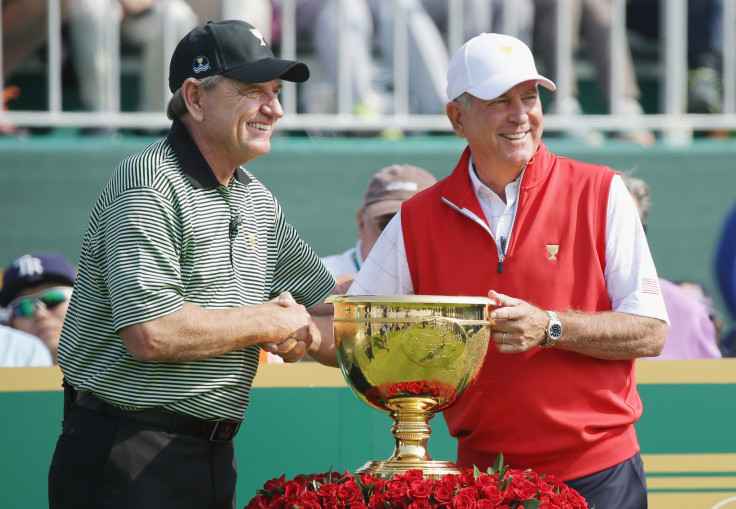Jack Nicklaus’ 1986 Masters Win: The Golden Bear’s Opponents Describe The Incredible Comeback

On the tee at the Augusta National Golf Club’s 16th hole — staring down a green 170 yards away guarded by a water hazard in the front and a sand bunker in the back — Jack Nicklaus pulled out his five iron, waggled his hips and struck a pure shot. “Your destiny is right here,” Tom Weiskopf said on the CBS broadcast of the 1986 Masters Tournament, speaking over the airwaves as if sending karmic encouragement to the aging golfer nicknamed the Golden Bear.
As the ball cut through the air on its way to the green, Nicklaus’ oldest son, Jack Nicklaus Jr., who was caddying for his father that day, muttered, “Be right,” willing the ball toward the hole.
But the then-46-year-old Nicklaus, who had been written off by almost everybody at that point, didn’t watch the shot travel, but instead bent down slowly to pick up his tee. “It is,” he told his son.
The ball landed on the green and skittered toward the hole, coming to a stop just 3 feet away. In the midst of a stunning final round comeback that was capped by Nicklaus earning his 18th major title in what may have been the greatest Masters ever, the fabled golfer knew it was his day.
Mark McCumber, then a 34-year-old pro who’d been on the PGA Tour for seven years, knew it, too. He was readying to tee off at Augusta’s 17th hole, on a spot elevated above the 16th hole’s green, as he watched his competitor’s shot play out. “You see him make the swing, the sound when it landed, [the crowd] was deafening,” McCumber said in an interview with International Business Times this week.
“It was a roar,” said McCumber, now a 64-year-old golf course designer after nearly two decades of playing on the tour. “And then as the ball hopped for the left, it was a gasp, like, ‘It’s going to go in!’ That’s where I’m thinking, ‘This is historic, this is something for the ages.’ ”
Nicklaus went on to tap in the 3-foot putt to earn a birdie on the 16th hole, gaining another stroke on the leader during an incredible charge to win on the final nine holes of the tournament after trailing by six shots. While Nicklaus was already considered one of the top golfers in history, even his competitors believed his career had entered its twilight before the four-day tournament. The Golden Bear, who earned the nickname because of his blond locks and stocky build, proved everybody wrong during the final nine holes of the 1986 Masters that Sunday.
Three decades later, the 2016 Masters Tournament set to conclude Sunday is absent casual-fan favorite Tiger Woods. Given that vacancy, Augusta, already a nostalgia factory, and its broadcaster CBS are playing up the 1986 tournament anniversary in an attempt to cash in on one of the game’s favorite memories. The pros who played against the greatest golfer of all time that year detailed to International Business Times a day at Augusta unlike any other, helping to explain why, even 30 years later, Nicklaus’ victory is such a powerful selling point.
Watch Jack Nicklaus play the final nine holes at the 1986 Masters Tournament. (Note: Footage of the 16th hole begins at 2:10.)
Just days before the beginning of the 2016 tournament, the notoriously hermitic Masters — you can buy official gear with “The Masters” brand name only in Augusta and only during the tournament — released the full CBS broadcast of the 1986 tournament. In sports circles (especially the smaller golf circle), it stirred up conversation online. Jumping on board, the Golf Channel premiered Tuesday a documentary about Nicklaus’ legendary day. And Jim Nantz, a Masters fixture who made his Augusta debut in ’86, will call the final round on the CBS broadcast Sunday. In the lead-up to the tournament this year, Nantz said in a CBS interview of Nicklaus’ iconic performance: “I’ve talked about it more than any single day in my life. ... When it’s all said and done, one of the great days of my life.”
It’s a safe bet Nantz will lay on thick nostalgia over the 30-year anniversary of Nicklaus’ final round on Sunday. And CBS could need that added angle. There’s a field of young stars in the 2016 Masters, but it’s missing Woods, who has proven to draw casual fans unlike any other modern golfer. “During his peak years — 1999 to 2006 — ratings typically fell about 25 percent when Woods was not participating in a given tournament,” Forbes wrote last year.
Woods came back in 2015 after missing the previous year, and he was among the top performers through the tourney’s third round. Unsurprisingly, CBS’ ratings were 48 percent higher on 2015’s Masters Saturday than they were on 2014’s Masters Saturday. Even as young star Jordan Spieth separated himself from the field to win in the final round Sunday last year, ratings stayed up by more than 25 percent. As Sporting News wrote this week, without Woods, the Masters is no longer “must-see TV.” And the 2016 ratings have already evidenced as much, with first-round viewership falling by about 25 percent.
“Obviously, Tiger not participating in the Masters leaves a huge void for the media. ... There’s this vacuum there that would have been filled with Tiger Woods: You’ve got to fill that vacuum with something,” said the golf writer Tom Clavin, who authored the book “One for the Ages” about Nicklaus’ 1986 Masters comeback.
The anniversary is “a good way to fill that vacuum,” Clavin said.
This all at comes at a time when golf is in decline in America with participation among young people, those 18 to 30, dropping 35 percent during the past decade, according to the Washington Post. Every year, more golf courses close than open, with an average of 137 closings every year since 2011, the Post reported in 2015.
Watch @jacknicklaus in the entire CBS broadcast of the final round of the 1986 Masters. https://t.co/nsWTJ6D0th pic.twitter.com/C2pTrFOf2X
— Masters Tournament (@TheMasters) April 6, 2016
Round 2: Best @TheMasters of past 30 years?
— ESPN Golf (@ESPNGolf) March 29, 2016
Video: ’86 https://t.co/lxGLTERKu8
Video: ’90 https://t.co/Zd5BNhxeat
Those who played in the 1986 Masters mostly remember the sounds. The roars of Augusta National’s fans — “the patrons,” as they’re called at the most hallowed golf course in the U.S. — shook the ground, writers at the time swore. The course is lined by tall pines and the sound of cheers bounce around, echoing to the other players. The golfers heard Nicklaus coming before they saw his incredible shots register on the leaderboard tracking who was moving up and who was moving down.
“You hear a lot of roars because the golf course, a lot of the holes are right next to each other,” said Donnie Hammond, who finished tied for 11th at the ’86 Masters.
Hammond, now 59, played almost two decades on the PGA Tour, but that year, in his first of four Masters appearances, he could hear the difference between the normal Augusta cheers and the booming shouts that accompanied Nicklaus’ charge.
It was normal volume, “plus another 50 percent,” said Hammond, who was 29 years old at the time. “You think, ‘Wow, that was a big roar coming ahead of us.’ ... Then you see Jack’s name getting on the leaderboard.”
Hammond had entered the day just one shot behind the leader, superstar Greg Norman. But Nicklaus had shifted into his major-winning gear, one that had lain dormant for six years, which nobody else could match.
“The Golden Bear — that was his week,” said Rick Fehr, a then-23-year-old who finished tied for 36th. It was a ho-hum performance for Fehr, now a 53-year-old golf teaching pro in Seattle, who won twice on the PGA Tour during a career that spanned more than a decade. When golf fans ask him about the ’86 Masters, what comes to mind is not himself but Nicklaus.
“Oh, yeah, I remember what Jack did,” he tells them.

There are three principal reasons why “what Jack did” has stood the test of time. First, at 46, he was the oldest player to ever win the tournament. Second, he clinched it with a magical, 11th-hour run on the final nine holes, sprinting past the competition with perfect shots, one after the other. And third, the competitors he bested encompassed the top players in the world, almost all of them in their respective primes. The top of the leaderboard was a who’s who of golf at the time, including Norman, Seve Ballesteros, Tom Kite, Payne Stewart and Tom Watson.
“It’s almost like a former heavyweight champion comes out of retirement years after his last victory and floors the champion when people were worried he wouldn’t survive the fight,” said the golf writer Clavin.
Nick Price, a star who would go on to win three major titles over his career, finished fifth in the 1986 Masters. If it weren’t for Nicklaus’ final run to victory, Price would have had the most memorable day of the tournament. After struggling in the first of the four rounds, Price improved on Day 2 and then compiled a Masters-record low score of 63 on Day 3. Three decades later, Price’s record still stands.
“That 63 was just a part of what was a phenomenal week of entertainment and probably the most entertaining Sunday of golf that I’ve been around,” Price told IBT this week over the phone from the 2016 Masters.
Although Nicklaus’ final bow on the majors’ stage may have overshadowed Price’s record-setting round, 30 years later, Price said that in a way the 46-year-old’s win only sweetened the feeling that came from shooting the best 18 holes in Masters history. His record round came in perhaps the most memorable Masters ever, which improbably was won by the best player in history. So Price was a major part of something bigger.
“Take anyone from behind and put them in the green jacket [given to the winner], it wouldn’t have nearly been the same,” Price said. “Everything else that week, including my 63, that led up to Sunday, was only enhanced by Jack’s win.”

McCumber, who was fighting off Nicklaus’ charge up the leaderboard in 1986, looked up to the best-ever golfer the way most young players of his time did. McCumber turned pro playing with a MacGregor brand driver designed by Nicklaus and with his name inscribed in the wood. After the two met during McCumber’s early years on the tour, Nicklaus would joke about the golf club, asking, “How’s our club?” One day, the older player noticed the driver had worn thin and soon afterward gave two brand-new clubs to the younger player.
So, as the final round of the 1986 Masters played out, and Nicklaus knocked in birdie after birdie, chipping away at a seemingly insurmountable deficit, McCumber had mixed feelings. He wanted to win. But it was the “most electric hour” of his life watching Nicklaus pull off the feat.
“Am I on a Disney exhibit here?” he thought. “It was a fairy tale.”
After seeing Nicklaus’ shot on the 16th hole and wrapping up his own final two holes, McCumber stuck around to watch the Golden Bear complete his round. That’s something he never did, because, after a round, you’re tired, overheated and just want to get some rest. But, as Nicklaus surged through the final holes and finished his round in the lead, daring anyone to catch him, McCumber knew something special was happening.
When you get a chance to witness history, you take it.
It’s like he was “right next to Babe Ruth,” McCumber said. “He’s going to hit this thing out of the park, and I’m on third base.”
© Copyright IBTimes 2024. All rights reserved.












